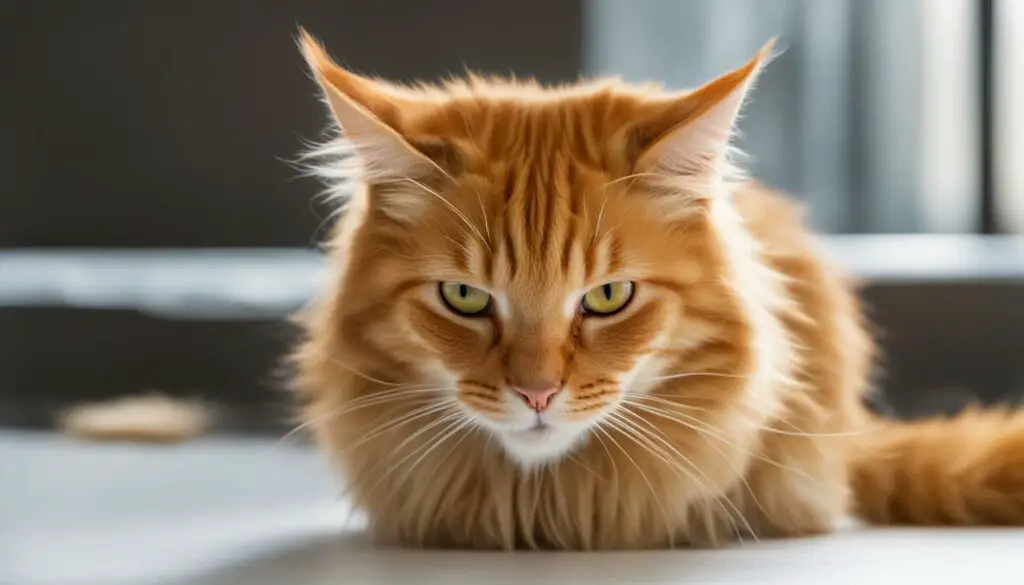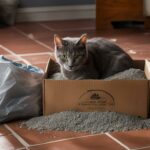Keeping your cat clean is an essential part of their hygiene and overall well-being. However, if you’ve noticed that your cat keeps getting poop stuck on their tail, it can be quite a messy and unpleasant experience for both you and your feline friend. In this guide, I will explore the various reasons why this may be happening and provide solutions to help you address the issue.
Cats are known for their cleanliness and instinct to bury their waste in the litter box. So, why is your cat struggling with poop sticking to their tail? There could be several reasons behind this problem, including litter box training issues, pain or discomfort, cleanliness of the litter box, and more. By understanding and addressing these factors, you can prevent poop from getting stuck on your cat’s tail and maintain a clean and healthy environment for your furry companion.
Key Takeaways:
- Lack of proper litter box training can contribute to poop getting stuck on your cat’s tail. Consider providing a poop-covering lesson to help your cat understand how to bury their waste in the litter box.
- Pain or discomfort can make it difficult for cats to properly use the litter box. Consult with your vet to identify and address any underlying health issues that may be causing your cat’s discomfort.
- The cleanliness of the litter box is crucial. Make sure to provide multiple clean litter boxes for your cats and keep them well-maintained. Consider using litter boxes with walk-up entrances or low-bottomed entryways to encourage proper use.
- Preventing tracking with litter box design can help minimize poop sticking to your cat’s tail. Explore litter boxes with a stacked design, use litter mats, and choose litter specifically designed to minimize tracking.
- Proper grooming and fur maintenance, especially for long-haired cats, can help prevent poop from sticking to their fur. Regular trimming and grooming around the rectum and between the legs can make a significant difference.
Lack of Litter Box Training
| Advantages | Disadvantages | |
|---|---|---|
| Kitten Litter Box Training | – Kittens learn from their mother and litter-mates – Teaches proper bathroom behavior – Helps establish a routine |
– May miss training if rescued at a young age – Requires patience and consistency |
| Poop-Covering Lesson | – Demonstrates how to cover waste in the litter box – Promotes cleanliness and hygiene |
– Requires gentle handling and supervision |
Litter box training is crucial for kittens to develop proper bathroom behavior. However, some cats may lack this training due to various reasons, such as being bottle-fed or rescued at a young age. To address this issue, providing a poop-covering lesson can help teach cats how to cover their waste in the litter box.
Kitten litter box training allows them to learn from their mother and litter-mates, helping establish a routine and teach them proper bathroom behavior. However, if a kitten is rescued at a young age or doesn’t have access to their mother, they may miss out on this crucial training. In such cases, a poop-covering lesson can be beneficial.
A poop-covering lesson involves gently taking your cat’s paws and showing them how to cover their waste in the litter box. This not only promotes cleanliness and hygiene but also helps cats understand the proper use of the litter box. It may require patience and consistency, but it can significantly improve litter box habits and minimize tracking issues.
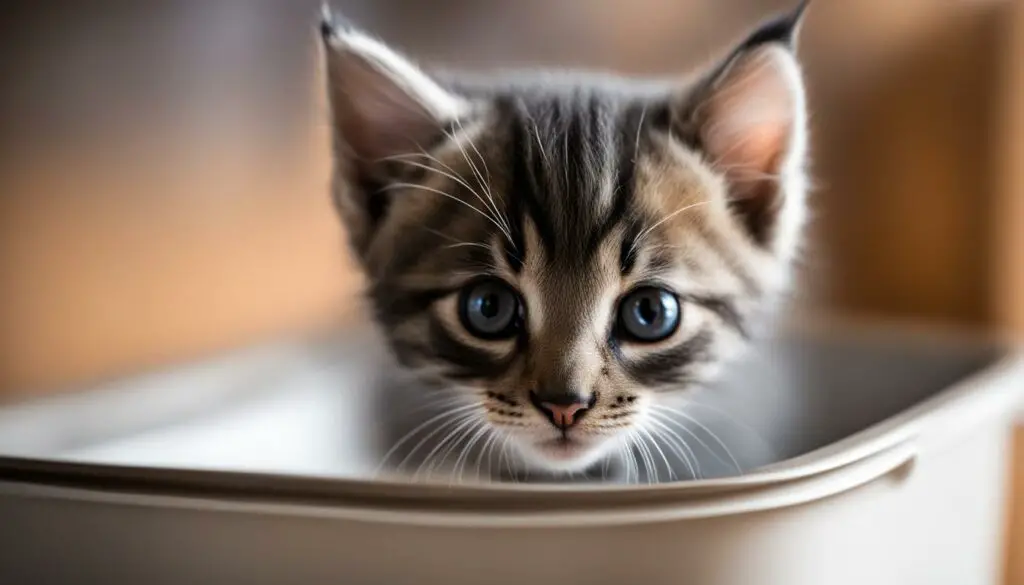
Training Tips:
- Choose a quiet and secluded area for the litter box to minimize distractions.
- Ensure the litter box is easily accessible and at an appropriate height for kittens.
- Use a litter that is soft and non-clumping for kittens to avoid any discomfort.
- Reward your kitten with praise or treats when they use the litter box properly.
- Be patient and consistent in providing the poop-covering lesson until your cat develops the desired litter box habits.
By addressing the lack of litter box training and providing proper guidance, you can help your cat develop good litter box habits and minimize the issue of poop getting stuck on their tail.
Pain or Discomfort
Cats can experience pain or discomfort that may affect their ability to use the litter box properly. Various factors can contribute to this, including medical conditions and certain procedures like declawing. It’s important to address these issues to ensure your cat’s comfort and cleanliness.
Medical Conditions
Cats suffering from chronic ailments such as arthritis or hip dysplasia may find it difficult to move around and access the litter box. These conditions can cause pain and discomfort, making it challenging for cats to use their paws effectively. Consulting with your veterinarian is crucial to determine the best course of action and provide appropriate treatment to alleviate your cat’s pain.
Declawing
Declawing is a procedure that involves the removal of a cat’s claws and is often accompanied by acute and chronic limb pain. Cats rely on their claws for balance and mobility, and removing them can lead to discomfort. This can affect their ability to dig in the litter and cover their waste effectively. Avoiding declawing or providing suitable alternatives such as scratching posts can help prevent pain and maintain your cat’s litter box habits.
| Chronic Ailments | Pain Level |
|---|---|
| Arthritis | Moderate |
| Hip Dysplasia | Severe |
By addressing pain or discomfort, you can ensure that your cat experiences minimal disruption to their litter box routine and hygiene. Consult with your veterinarian to determine the best course of action and provide the necessary treatment for your cat’s specific condition.
Cleanliness of the Litter Box
Ensuring that the litter box is clean and well-maintained is crucial for preventing poop from getting stuck on your cat’s tail. Cats are naturally clean animals and prefer to use a pristine litter box. By following a few simple steps, you can create an environment that encourages proper litter box usage and minimizes tracking.
Multiple Litter Boxes
One important aspect of maintaining a clean litter box is to have enough of them for your cats. It’s recommended to have one more litter box than the number of cats you have. For example, if you have two cats, you should provide three litter boxes. This ensures that each cat has access to a clean litter box at all times. Place the litter boxes in different locations to give each cat privacy and prevent them from interfering with each other’s business.
Walk-Up Entrances
Consider using litter boxes with walk-up entrances or low-bottomed entryways. Some cats may have difficulty accessing litter boxes with high sides or covered designs, leading to accidents or tracking. Litter boxes with walk-up entrances provide easy access for cats of all ages and sizes, reducing the chances of poop getting stuck on their tails. These types of litter boxes are especially beneficial for older cats or those with mobility issues.
| Litter Box Location | Walk-Up Entrance |
|---|---|
| In a quiet and private area | Allows easy access for cats |
| Away from food and water bowls | Reduces chances of contamination |
| Separate from sleeping and eating areas | Promotes good hygiene |
Creating a clean and conducive litter box environment for your cat is essential for preventing poop from getting stuck on their tail. By providing multiple litter boxes, choosing ones with walk-up entrances, and ensuring proper cleanliness, you can maintain your cat’s hygiene and minimize tracking.
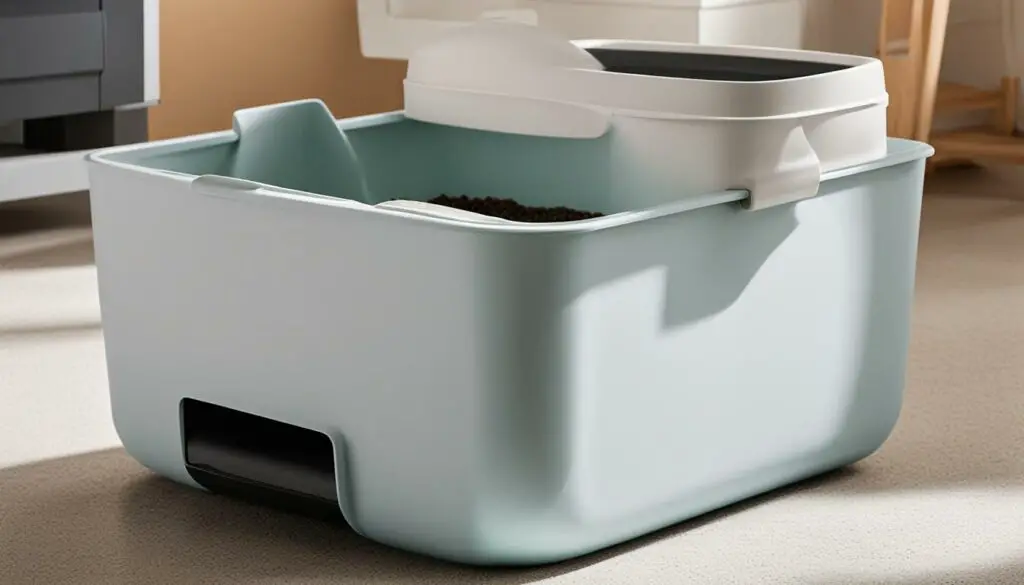
Preventing Tracking with Litter Box Design
When it comes to keeping your cat’s tail clean and preventing poop from getting stuck, the design of the litter box plays a crucial role. By choosing the right features and accessories, you can minimize tracking and maintain a cleaner environment for your feline friend.
Litter Box Design
One effective solution is using stacked litter boxes. This design involves placing multiple litter boxes of the same size on top of each other. As your cat uses the top box, clean litter sifts down to the lower boxes, while waste is collected in the top box. This helps to prevent your cat from stepping on or dragging litter and feces around the house.
Another option is using litter mats. These mats are placed at the edge of the litter box and help to catch litter particles as your cat exits the box. By trapping the litter on the mat, it reduces the likelihood of it sticking to your cat’s paws or tail.
Minimizing Tracking with Litter Box Accessories
In addition to the design of the litter box itself, there are accessories that can further minimize tracking. For example, some litter boxes come with built-in walk-up entrances, which help to prevent litter from being scattered outside of the box as your cat enters or exits. Additionally, low-bottomed entryways can make it easier for your cat to step in and out of the box, reducing the chances of litter getting stuck to their paws or tail.
Furthermore, certain types of litter are specifically designed to minimize tracking. These litters are often made of larger granules that are less likely to stick to your cat’s paws or tail. They also have better clumping properties, which make it easier to clean the litter box and remove any soiled litter.
To ensure the effectiveness of these litter box design solutions, it’s important to regularly clean and maintain the litter boxes. Keep the boxes in a well-ventilated area and scoop them daily to remove waste. This will not only keep the litter boxes fresh and clean but also encourage your cat to use them appropriately.
By implementing these litter box design strategies and accessories, you can minimize tracking and keep your cat’s tail clean and hygienic. Remember to choose a design that suits your cat’s preferences and comfort level, and regularly monitor and address any issues that may arise. With a well-designed litter box and proper maintenance, you can provide your cat with a clean and comfortable toileting experience.
Table: Pros and Cons of Litter Box Design Solutions
| Litter Box Design Solution | Pros | Cons |
|---|---|---|
| Stacked Litter Boxes | – Reduces tracking by collecting waste in the top box – Allows clean litter to sift down to lower boxes |
– Requires additional space for stacked boxes – May be less visually appealing |
| Litter Mats | – Catches litter particles to prevent tracking – Easy to clean and maintain |
– Some cats may dislike the texture of the mat – Mats need regular cleaning to prevent odor buildup |
| Walk-up Entrances | – Prevents litter from being scattered outside the box – Provides easy access for cats |
– May not fit in small or enclosed spaces – Cats with mobility issues may find it challenging to use |
| Low-Bottomed Entryways | – Makes it easier for cats to step in and out of the box – Reduces the likelihood of litter sticking to paws or tail |
– May allow litter to be kicked out of the box more easily – Some cats may prefer higher-sided boxes for privacy |
| Litter Specifically Designed to Minimize Tracking | – Larger granules are less likely to stick to paws or tail – Better clumping properties for easy cleaning |
– May be more expensive than regular litter – Some cats may be resistant to switching to a new type of litter |
Choosing the Right Litter Box Size
When it comes to preventing poop from getting stuck on your cat’s tail, choosing the right litter box size is essential. Many pet store litter boxes are designed with kittens or small cats in mind, which may not provide enough space for larger adult cats. To ensure your cat has enough room to maneuver comfortably, consider using alternative options such as storage containers, utility tubs, or sandboxes as larger litter boxes.
Using a larger litter box allows your cat to enter, move around, and position itself without the risk of feces sticking to its tail. These alternatives provide ample space for your cat to comfortably squat and bury its waste, minimizing the chances of tracking. Additionally, larger litter boxes are easier to clean and maintain, promoting better overall litter box hygiene.
By opting for a larger litter box, you can create a more comfortable and appropriate environment for your cat’s bathroom habits. This ensures that your cat can eliminate waste without the hassle of dealing with messes caused by poop sticking to its tail. Remember to choose a size that accommodates your cat’s specific needs and preferences, promoting a cleaner and more stress-free litter box experience for both you and your feline companion.
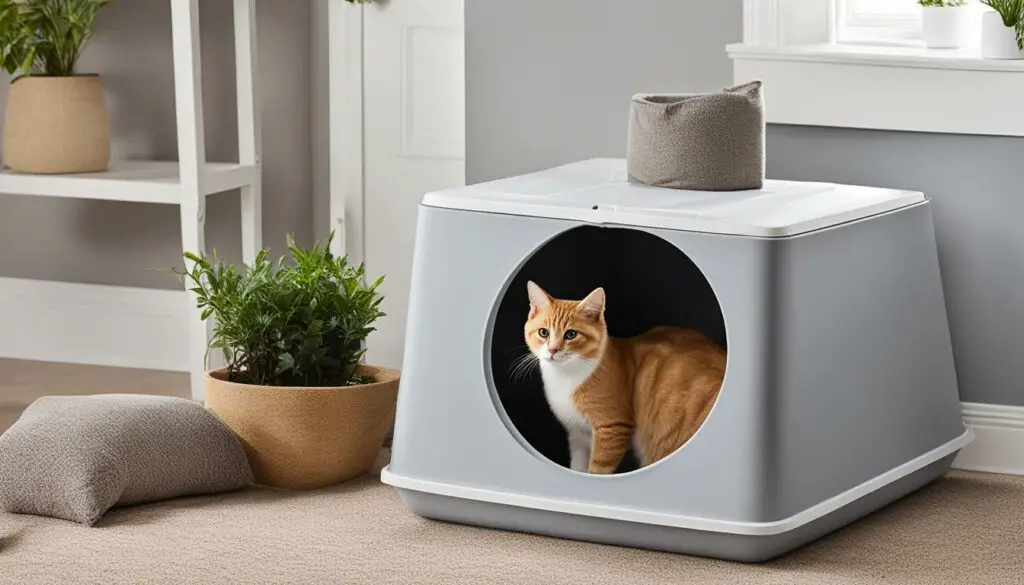
Table: Comparison of Litter Box Sizes
| Litter Box Type | Dimensions (Length x Width x Height) | Recommended Cats |
|---|---|---|
| Standard Pet Store Litter Box | 17″ x 13″ x 6″ | 1 small cat or kitten |
| Large Storage Container | 24″ x 18″ x 10″ | 1-2 medium-sized cats |
| Utility Tub | 28″ x 18″ x 12″ | 2-3 cats |
| Sandbox | 36″ x 24″ x 12″ | 3-4 cats |
Table demonstrates a comparison of different litter box sizes, highlighting the dimensions and recommended number of cats for each option. Consider these alternatives to pet store litter boxes to ensure your cat has enough space to eliminate waste comfortably.
Proper Grooming and Fur Maintenance
Long-haired cats require extra attention when it comes to grooming and fur maintenance. Their beautiful, flowing coats can easily trap litter and feces, leading to unsightly messes and potential hygiene issues. By implementing a regular grooming routine and incorporating specific techniques, you can help prevent poop from sticking to your cat’s fur and ensure their overall cleanliness.
Fur Trimming: One effective method is to regularly trim the fur around your cat’s rectum and between their legs. This helps to minimize material accumulation and reduces the chances of feces getting stuck. Use grooming scissors or clippers to carefully and gently trim the feathers, ensuring that you do not get too close to the skin. It is important to exercise caution and make sure your cat feels comfortable during the process.
Regular Grooming: In addition to trimming, regular grooming sessions are essential for long-haired cats. Use a cat-specific brush or comb to remove any tangles or mats in their fur. This not only helps to maintain their coat’s cleanliness but also enhances their overall appearance and prevents potential skin irritations. Gently brush or comb your cat’s fur in the direction it naturally grows, paying extra attention to the areas prone to trapping litter and feces.
Expert Tip: “Maintaining good fur hygiene is crucial for long-haired cats. Regular grooming and trimming can help prevent poop from sticking to their fur and promote a clean and healthy coat.” – Dr. Debra
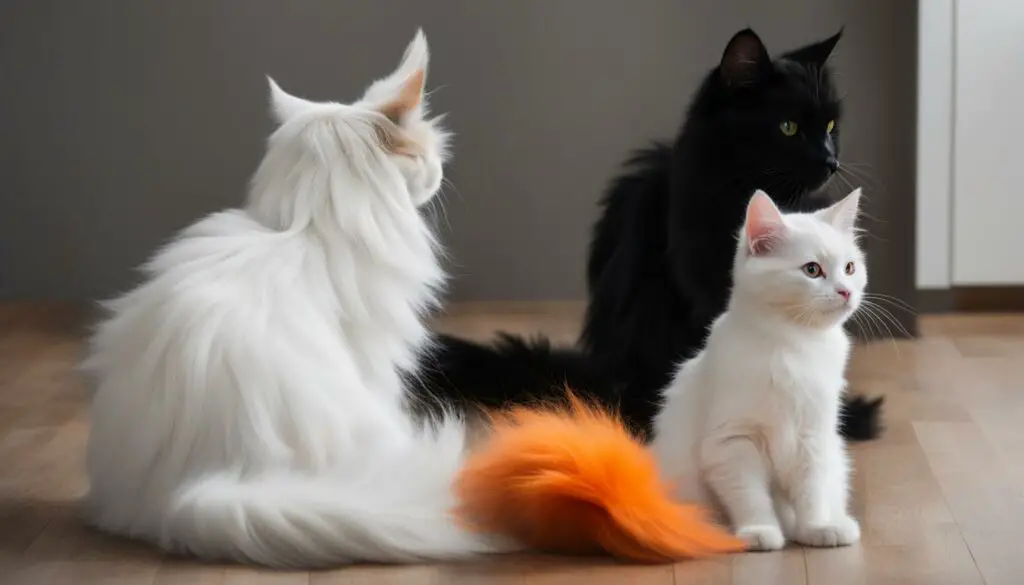
Additional Tips
- Keep the fur around the rectum and between the legs clean and free from excess feces by gently wiping with cat-safe wipes or a damp cloth.
- Consider using specialized products such as pet-safe detangling sprays or waterless shampoos designed to remove debris from the fur without the need for a full bath.
- Regularly check your cat’s fur for any signs of matting or entanglement. If you notice any mats, carefully work them out with your fingers or a comb to prevent larger issues.
- Provide your cat with a clean and comfortable environment, ensuring their litter box is well-maintained and easily accessible.
By following these grooming practices and integrating them into your cat’s routine, you can minimize the occurrence of poop sticking to their fur and maintain their overall hygiene. Regular maintenance and care will help keep your long-haired companion looking and feeling their best.
Monitoring Stool Consistency and Health
Monitoring your cat’s stool consistency is an important aspect of maintaining their overall health and preventing poop from getting stuck on their tail. Soft stools or diarrhea can be indicators of underlying health issues that may contribute to tracking and messes in the litter box. It’s essential to pay attention to your cat’s poop and consult with your veterinarian if you notice any abnormalities.
Abnormal stool consistency can be caused by various factors, such as inflammatory bowel disease, intestinal parasites, or food allergies. By monitoring your cat’s poop, you can identify potential health problems early on and seek appropriate treatment. Your veterinarian may recommend diagnostic tests, such as fecal examinations, blood work, or imaging, to determine the underlying cause of the soft stools or diarrhea.
“Regular monitoring of your cat’s stool consistency allows you to catch any potential health issues before they worsen,” says Dr. Sarah Thompson, DVM. “It’s important to provide your veterinarian with detailed information about your cat’s poop, including its consistency, frequency, and any additional symptoms.”
In addition to monitoring stool consistency, it’s crucial to ensure that your cat’s diet is appropriate for their digestive health. High-quality cat food with balanced nutrition can promote healthy digestion and firmer stools. If necessary, your veterinarian may recommend dietary modifications or supplements to improve your cat’s stool consistency.
| Stool Consistency | Possible Causes |
|---|---|
| Firm, well-formed | Healthy digestion |
| Soft, mushy | Potential digestive issues |
| Watery, diarrhea | Underlying health problems |
Remember to regularly observe your cat’s litter box and take note of any changes in their stool consistency. This information will be valuable during your discussions with the veterinarian and help ensure your cat’s health and cleanliness.
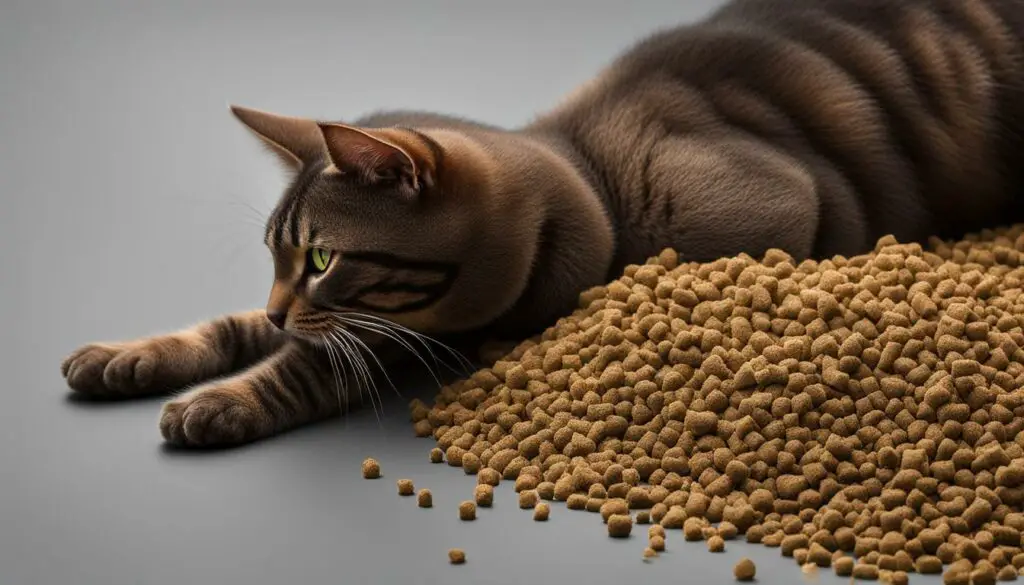
Veterinary Treatment for Fecal Mat Issues
If your cat has a fecal mat issue, it is important to seek veterinary treatment to address the problem. Fecal mats occur when feces becomes matted in your cat’s fur, often around the rectal area. This can lead to discomfort, skin irritation, and potential health complications.
The initial step in veterinary treatment is to carefully remove the fecal mat. This may involve cutting off the affected hair or shaving the area to eliminate the mat. It is essential to approach this process with caution and seek professional help, as improper handling can cause harm to your cat.
After the fecal mat has been addressed, your cat will require thorough grooming to ensure the elimination of any remaining bacteria or fecal matter. The veterinarian may wash your cat using appropriate cleansing products to maintain hygiene. Depending on the severity of the issue and any complications caused by the fecal mat, additional treatment options may be recommended.
| Treatment Options | Description |
|---|---|
| Grooming | Regular grooming sessions can help prevent future fecal mat issues. This includes brushing your cat’s fur to remove loose hair and prevent matting. |
| Medication | In some cases, your veterinarian may prescribe medication to address any underlying health conditions or skin irritations caused by the fecal mat. This may include topical treatments or oral medication. |
| Preventive Measures | Once the fecal mat issue has been resolved, it is essential to take preventive measures to avoid recurrence. These measures may include maintaining regular grooming, monitoring your cat’s diet and stool consistency, and addressing any potential health issues promptly. |
Remember, veterinary treatment is crucial to address fecal mat issues and ensure the well-being of your cat. Regular grooming, preventive measures, and prompt medical attention can help minimize the risk of future problems and keep your feline friend healthy and comfortable.
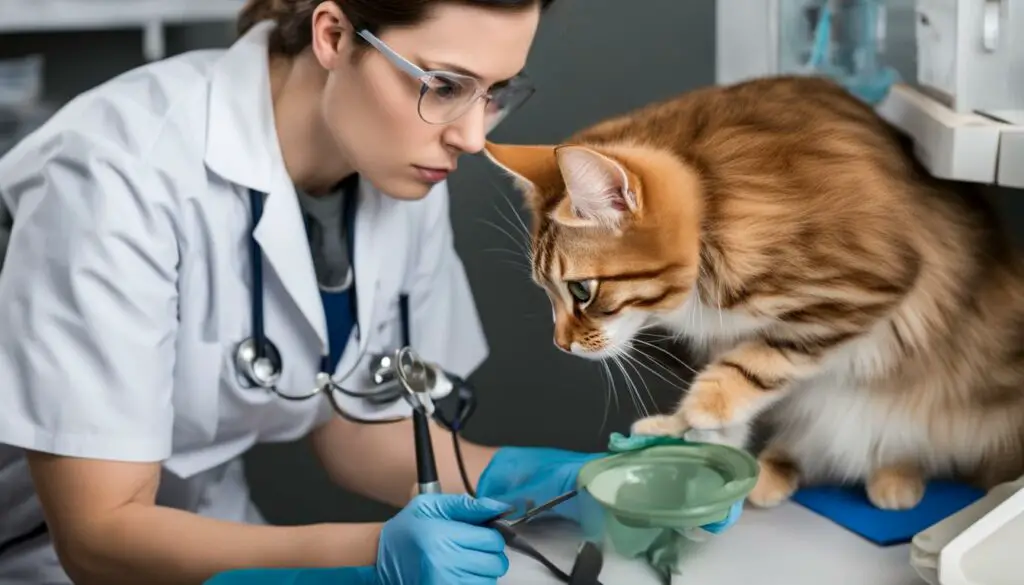
Additional Solutions for Poop Stuck on Tail
When it comes to preventing poop from sticking to your cat’s tail, there are a few additional solutions that you can consider. These measures can help ensure your cat’s comfort and maintain cleanliness in your home.
- Stool Softeners and Laxatives: Administering stool softeners or laxatives can help regulate your cat’s bowel movements and prevent the stool from becoming too firm. This can make it easier for your cat to pass stool without it sticking to their tail. Consult with your veterinarian to determine the appropriate dosage and type of medication for your cat.
- Hair Clipping and Shaving: Trimming the fur around your cat’s rectum and feathers can minimize material accumulation and reduce the chances of poop getting stuck. Use caution when using scissors or clippers near your cat’s skin to avoid any accidental injuries. If you’re unsure about the process, consider seeking professional grooming services.
- Regular Grooming: Maintaining a grooming routine for your cat can go a long way in preventing poop from sticking to their tail. Regular brushing can help remove any loose fur and debris, reducing the chances of material getting tangled and stuck. Additionally, keeping your cat’s fur clean and free from mats can also minimize the chances of poop clinging to their tail.
By implementing these additional solutions, you can take proactive steps to prevent poop from sticking to your cat’s tail and maintain a clean and hygienic environment for your feline companion.

Grooming Tips for Long-Haired Cats
Long-haired cats require extra attention when it comes to grooming. Here are a few tips to help keep their fur clean and prevent poop from sticking:
- Regularly brush your cat’s fur to remove any loose hair and prevent matting.
- Pay special attention to the fur around the rectum and between the legs, as these areas are prone to material accumulation.
- If your cat’s fur is especially long and prone to matting, consider scheduling regular professional grooming sessions.
Remember, maintaining good hygiene for your cat is essential for their overall health and well-being. By implementing these grooming tips and additional solutions, you can help prevent poop from sticking to your cat’s tail and ensure their comfort and cleanliness.
Ask Dr. Debra Response
I received a question from a reader about long-haired cats and the issue of feces getting caught in their hair. This is a common concern, especially for cat owners with breeds that have long, fluffy fur. Here is my advice on grooming practices to prevent poop from sticking and promote the overall health of your long-haired cat.
Grooming Advice
Regular grooming is key to preventing feces from getting tangled in your cat’s fur. Start by trimming the feathers around the rectum and between the legs. This will minimize the risk of waste getting caught in the longer hair strands. Use scissors or a clipper with caution and take your time to avoid any accidents or injuries to your cat. If you’re not comfortable doing this yourself, consider taking your cat to a professional groomer.
Trimming Feathers and Shaving
Trimming the feathers on your cat’s hind end can help reduce the risk of poop getting stuck in the fur. Be careful not to cut too close to the skin, as this can cause irritation or discomfort. If your cat has persistent issues with feces getting caught, you may need to trim the hair more closely or consider shaving the area around the rectum. However, shaving should only be done under the guidance of a professional groomer or veterinarian.
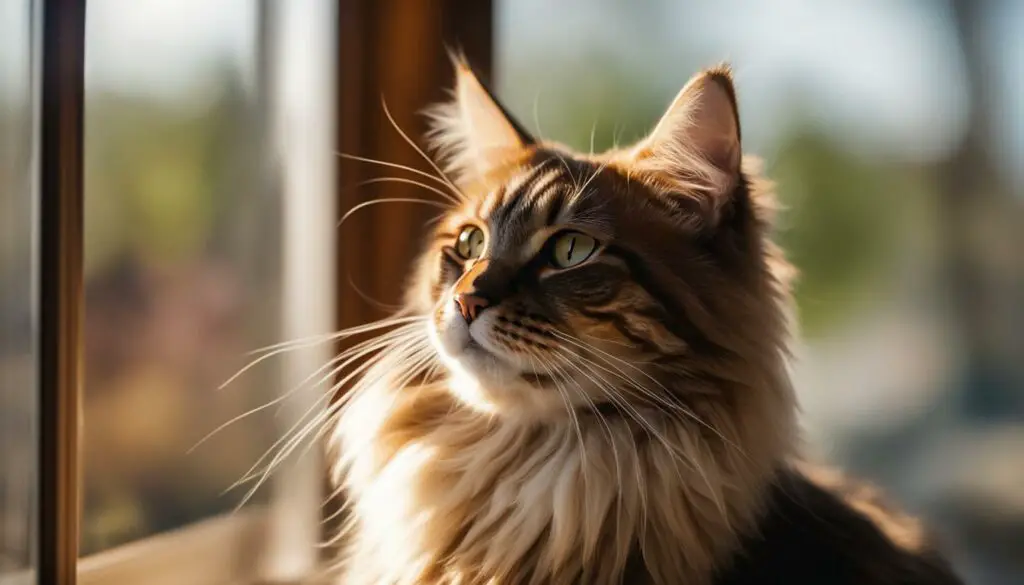
Promoting Cat Health
In addition to grooming, it’s important to prioritize your cat’s overall health. Make sure your cat is on a balanced diet that promotes regular, firm bowel movements. Adding a small amount of pumpkin or Metamucil to their food can help firm up their stools. If you notice any changes in your cat’s bathroom habits or signs of discomfort, it’s essential to consult with your veterinarian. They can provide guidance on your cat’s specific needs and recommend any necessary treatments or interventions.
Remember, maintaining good hygiene and preventing feces from getting stuck on a long-haired cat’s tail requires regular grooming, trimming of feathers, and being attentive to their overall health. By following these practices, you can ensure a clean and comfortable living environment for your feline friend.
Conclusion
Keeping your cat’s tail clean and preventing poop from getting stuck is important for their hygiene and comfort. By addressing litter box issues, implementing proper grooming practices, and seeking veterinary treatment when necessary, you can minimize tracking and maintain a clean and healthy environment for your feline friend.
Proper litter box training is crucial, especially for kittens who may have missed out on this essential lesson. Taking the time to provide a poop-covering lesson can help them understand how to use the litter box effectively.
In addition, ensuring your cat is not experiencing any pain or discomfort is essential. Consulting with your vet to identify and address any health issues, like arthritis or limb pain caused by declawing, can make a significant difference in their litter box habits.
Giving careful attention to the cleanliness of the litter box is another important factor. Having one more litter box than the number of cats you have, placing them at a distance from each other, and keeping them clean can encourage proper use.
Remember to also consider the design of the litter box itself. Using stacked litter boxes or litter mats can help prevent tracking and minimize messes. And don’t forget that choosing the right size litter box for your cat’s needs is essential for their comfort and cleanliness.
Lastly, proper grooming and monitoring of your cat’s stool consistency are crucial. Regularly trimming their fur, especially around the rectum, and keeping an eye on their stool health can prevent material accumulation and ensure their hygiene.
By following these guidelines and seeking professional help when necessary, you can create a clean and healthy environment for your cat, promoting their overall well-being and happiness.
FAQ
What can I do if my cat is not properly trained to use the litter box?
Kittens learn proper litter box behavior from their mother and litter-mates. If your cat missed out on this training, you can gently take its paws and show it how to cover its waste in the litter box.
Why would my cat have difficulty using the litter box or covering its waste?
Cats in pain may have difficulty using the litter box or covering their waste. Procedures like declawing and chronic ailments such as arthritis or hip dysplasia can affect a cat’s mobility. Consult with your vet to address any pain or discomfort your cat may be experiencing.
How can I ensure my cat’s litter box is clean enough for it to use?
Cats are particular about the cleanliness of their litter boxes. It’s recommended to have one more litter box than the number of cats you have. Additionally, the litter boxes should be placed at a distance from each other, with each cat only able to see the box it’s using. Clean and well-maintained litter boxes can encourage proper use.
How can I prevent litter tracking?
To prevent tracking, you can use litter boxes with a stacked design or litter mats placed at the edge of the litter box. Certain types of litter are also designed to minimize tracking.
What should I do if my cat is too big for standard pet store litter boxes?
If your cat is too big, you can use alternative options such as storage containers, utility tubs, or sandboxes as larger litter boxes.
How can I prevent poop from sticking to my cat’s fur?
Regular grooming and trimming of your cat’s fur, especially around the rectum and between its legs, can help prevent poop from sticking to its fur.
What does abnormal stool consistency indicate?
Abnormal stool consistency can indicate health issues such as inflammatory bowel disease, intestinal parasites, or food allergies. Keep an eye on your cat’s stool consistency and consult with your vet to address any potential health problems.
What veterinary treatment is necessary for fecal mat issues?
Veterinary treatment for fecal mat issues may involve removing the mat by cutting off affected hair or shaving the area. Your vet will also thoroughly wash your cat to eliminate any remaining bacteria or fecal matter. Treatment may also include addressing any complications caused by the mat.
Are there additional solutions for poop stuck on a cat’s tail?
Additional solutions may include administering stool softeners or laxatives, clipping or shaving the fur around the rectum and feathers, and maintaining regular grooming practices.
What advice does Dr. Debra give for long-haired cats with poop caught in their hair?
Dr. Debra advises keeping the hair around a long-haired cat’s rectum and between its legs trimmed to prevent poop from sticking. She also suggests adding pumpkin or Metamucil to the cat’s diet to firm up the stools, but advises caution when using scissors near a cat’s skin.
Source Links
- https://www.thesprucepets.com/cats-tracking-poop-553999
- https://wagwalking.com/cat/condition/fecal-mat
- https://www.petplace.com/article/cats/vet-qa-parent/vet-qa/longhaired-cat-gets-feces-stuck-on-fur

